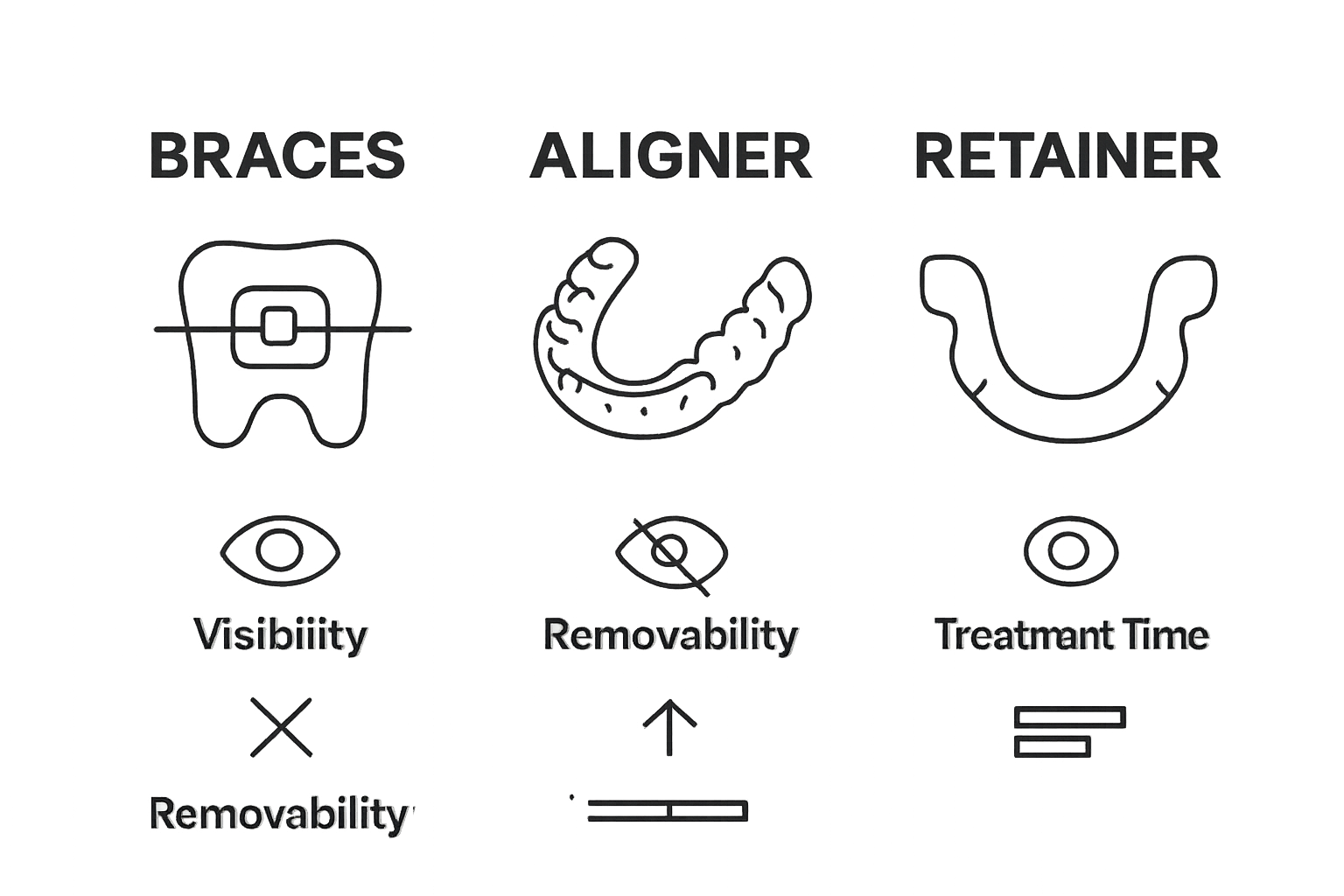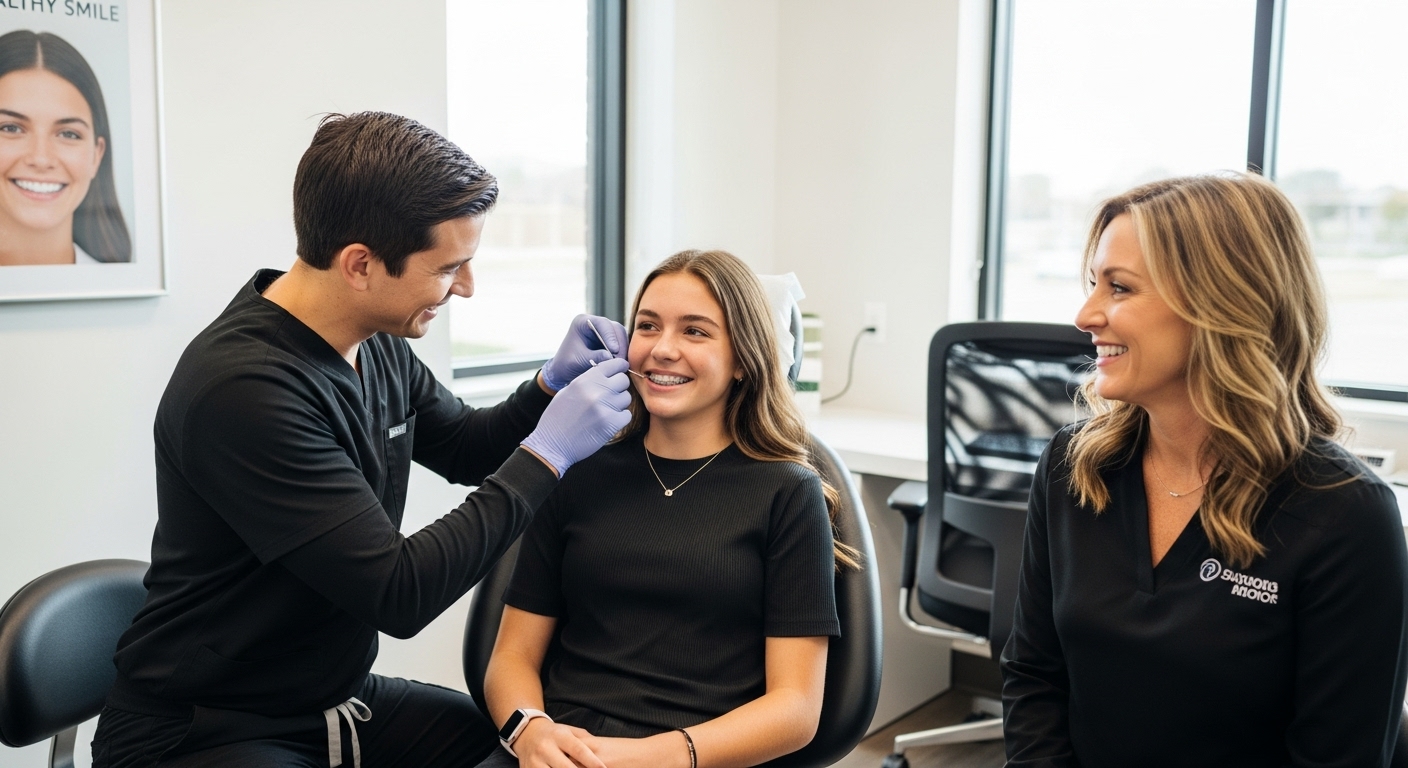What is Orthodontics? Understanding Braces and Aligners
September 30, 2025
What is Orthodontics? Understanding Braces and Aligners
Orthodontics is more than just straightening teeth for a perfect smile. In fact, orthodontic treatment can dramatically lower the risks of tooth decay, gum disease, and even jaw pain for people of all ages. Most people think it is all about appearances, but the real power of orthodontics shows up in your long-term health, comfort, and confidence.
Table of Contents
- Defining Orthodontics: The Science Behind Alignment
- The Importance of Orthodontics: Why It Matters for All Ages
- How Orthodontics Works: Treating Misalignments and Bites
- Exploring Orthodontic Options: Braces, Aligners, and More
- The Long-Term Benefits of Orthodontic Care: A Healthy Smile
Quick Summary
| Takeaway | Explanation |
|---|---|
| Orthodontics improves both function and aesthetics | Treatment not only creates a beautiful smile but also ensures optimal dental function and health. |
| Early assessment can prevent complex issues | Children should have initial orthodontic evaluations around age seven to intercept potential misalignments. |
| Misaligned teeth pose significant health risks | Untreated dental misalignment can lead to pain, decay, and other systemic health issues. |
| Various orthodontic options are available | Modern treatments include traditional braces, clear aligners, and other innovative solutions to meet patient needs. |
| Orthodontics positively impacts self-esteem | Improved dental alignment can boost confidence, enhancing social interactions and overall mental well-being. |
Defining Orthodontics: The Science Behind Alignment
Orthodontics is a specialized branch of dentistry focused on diagnosing, preventing, and correcting misaligned teeth and jaw structures. What is orthodontics fundamentally involves understanding how teeth and facial bones can be strategically moved to create optimal alignment, function, and aesthetic appearance.
The Core Principles of Tooth Alignment
The scientific foundation of orthodontics centers on biomechanical principles that enable controlled movement of dental structures. Orthodontists utilize precise mechanical forces to gradually shift teeth into their ideal positions. According to American Association of Orthodontists, these movements are achieved through carefully calibrated pressure applied by braces, aligners, or other orthodontic appliances.
Key principles of tooth movement include:
- Bone remodeling through sustained pressure
- Understanding individual tooth root structures
- Calculating precise mechanical forces required for repositioning
The process involves complex interactions between applied mechanical forces and biological tissue responses. When consistent pressure is applied to a tooth, the surrounding bone undergoes a remarkable transformation.
Bone cells called osteoblasts and osteoclasts work simultaneously to break down and rebuild bone tissue, allowing teeth to gradually shift into their intended positions.
Technological Advancements in Orthodontic Science
Modern orthodontics has evolved dramatically with technological innovations. National Institutes of Health research highlights how advanced imaging techniques like 3D digital scans and computer-aided design have revolutionized treatment planning. These technologies enable orthodontists to create highly personalized treatment strategies that account for individual anatomical variations.
Today’s orthodontic approaches go beyond mere cosmetic adjustments. Professionals now recognize that proper dental alignment impacts overall oral health, speech function, and even psychological well-being. By addressing misalignments early, orthodontists can prevent potential long-term complications such as uneven tooth wear, jaw pain, and difficulty maintaining proper oral hygiene.
Ultimately, orthodontics represents a sophisticated blend of medical science, engineering principles, and individualized patient care. Each treatment plan is a unique journey toward achieving optimal dental harmony and functional alignment.
The Importance of Orthodontics: Why It Matters for All Ages
Orthodontic treatment extends far beyond cosmetic improvements, representing a critical healthcare intervention that impacts overall physical and psychological well-being across different life stages. Proper dental alignment is not just about creating an attractive smile but ensuring optimal oral functionality and preventing potential long-term health complications.
Health Implications of Dental Misalignment
Misaligned teeth can trigger a cascade of health challenges that many people do not initially recognize. According to American Dental Association, untreated orthodontic issues can lead to significant oral and systemic health problems. These potential complications include:
- Increased risk of tooth decay and gum disease
- Chronic jaw pain and temporomandibular joint disorders
- Difficulties with proper speech pronunciation
- Higher likelihood of abnormal tooth wear
- Potential breathing and sleep-related problems
The consequences of misalignment are not merely aesthetic but can profoundly impact an individual’s quality of life. Teeth that are crowded, widely spaced, or irregularly positioned create challenges for maintaining proper oral hygiene, which can escalate into more serious dental and health concerns.
Orthodontic Benefits Across Different Life Stages
Contrary to popular belief, orthodontic treatments are not exclusively for children and teenagers. Adults can significantly benefit from corrective dental procedures. National Health Services emphasizes that orthodontic interventions can address issues that develop or persist throughout one’s lifetime.
Children typically represent the primary candidates for early orthodontic assessment, with professionals recommending initial evaluations around age seven. During this critical developmental period, orthodontists can identify and intercept potential alignment issues before they become more complex. For teenagers, orthodontic treatments not only improve dental function but also boost self-confidence during crucial psychological development stages.
Adult orthodontic treatments have surged in popularity, with many individuals seeking corrections for long-standing dental misalignments. Modern technologies like clear aligners have made these interventions more accessible and less visually intrusive, enabling professionals to address complex dental repositioning with greater precision and aesthetic sensitivity.
Ultimately, orthodontics represents a proactive approach to healthcare.
To clarify how orthodontic care can benefit people at different ages, the table below summarizes the major advantages across life stages.
| Life Stage | Key Orthodontic Benefits |
|---|---|
| Childhood | Early detection and prevention of misalignment, easier correction |
| Teenage Years | Improved dental function, boosted self-confidence |
| Adulthood | Correction of long-standing issues, discreet treatment options |
| Older Adults | Maintenance of oral health, prevention of tooth wear and loss |
| By addressing dental alignment early and comprehensively, individuals can prevent potential complications, improve oral functionality, and enhance their overall quality of life across different age groups. |
How Orthodontics Works: Treating Misalignments and Bites
Orthodontic treatment represents a sophisticated process of strategic dental manipulation, utilizing precise mechanical principles to gradually transform tooth positioning and jaw alignment. Controlled movement of dental structures requires intricate understanding of biomechanical interactions between teeth, bone tissue, and applied orthodontic devices.
Biomechanical Principles of Tooth Movement
At its core, orthodontic treatment depends on applying consistent, carefully calculated pressure that stimulates biological remodeling processes. According to National Institutes of Health, orthodontic appliances generate mechanical forces that trigger cellular responses within bone and periodontal ligaments, enabling gradual tooth repositioning.
Key mechanisms of tooth movement include:
- Bone resorption on pressure points
- New bone formation in tension areas
- Cellular adaptations around tooth roots
- Gradual repositioning through sustained mechanical stress
When orthodontic devices apply steady pressure, specialized cells called osteoclasts break down bone tissue on the pressure side, while osteoblasts simultaneously build new bone tissue on the tension side. This synchronized process allows teeth to shift incrementally into their desired alignment without causing structural damage.
Types of Orthodontic Interventions
Orthodontists employ multiple strategies to address different misalignment scenarios. American Association of Orthodontists highlights several primary intervention approaches designed to correct specific dental challenges:
- Braces using metal or ceramic brackets
- Clear aligners for minimal visual intervention
- Palatal expanders for jaw width adjustments
- Headgear for complex jaw repositioning
- Retainers to maintain achieved dental alignments
Each intervention strategy is meticulously customized based on individual patient anatomy, age, and specific dental misalignment characteristics.
To help you compare the main orthodontic interventions discussed, here is a table outlining their distinctive features and typical uses.
| Orthodontic Intervention | Description | Typical Use |
|---|---|---|
| Metal Braces | Metal brackets and wires | Comprehensive correction, complex cases |
| Ceramic Braces | Tooth-colored brackets for aesthetics | Adults/teens seeking subtle appearance |
| Lingual Braces | Brackets placed behind teeth | Patients wanting hidden treatment |
| Clear Aligners | Removable, transparent trays | Mild to moderate misalignments, adults |
| Palatal Expanders | Device widens upper jaw | Addressing narrow palates, children |
| Headgear | External appliance influencing jaw growth | Severe skeletal misalignments, growing kids |
| Retainers | Maintain position after active treatment | All ages, post-orthodontic stabilization |
Ultimately, orthodontic treatment transforms dental structures through a delicate balance of mechanical engineering and biological responsiveness. By understanding and harnessing the body’s natural healing and adaptation mechanisms, orthodontists can guide teeth into harmonious alignments that enhance both oral functionality and aesthetic appearance.
Exploring Orthodontic Options: Braces, Aligners, and More
Modern orthodontic treatments offer diverse solutions tailored to individual dental needs, patient preferences, and specific alignment challenges.
 Comprehensive orthodontic care now encompasses multiple technologies designed to address a wide range of dental misalignment scenarios with increased comfort, efficiency, and aesthetic considerations.
Comprehensive orthodontic care now encompasses multiple technologies designed to address a wide range of dental misalignment scenarios with increased comfort, efficiency, and aesthetic considerations.
Traditional Braces: The Tried and True Method
Traditional metal braces remain a cornerstone of orthodontic treatment, offering reliable and comprehensive dental correction. According to American Association of Orthodontists, these systems utilize metal brackets and wires to apply consistent pressure, effectively repositioning teeth across various complexity levels.
Key characteristics of traditional braces include:
- Durable metal construction
- High predictability of tooth movement
- Suitable for complex dental realignments
- Cost-effective treatment option
- Appropriate for patients of all ages
Metal braces have evolved significantly, becoming smaller, more comfortable, and less visually intrusive compared to earlier generations. Contemporary designs focus on minimizing discomfort while maximizing treatment efficiency, making them a popular choice for comprehensive dental corrections.
Modern Alignment Alternatives
Advanced orthodontic technologies have expanded treatment possibilities beyond traditional metal braces. Dental Research Journal highlights emerging alternatives that provide patients with more flexible and aesthetically pleasing options:
- Clear ceramic braces blending with tooth color
- Lingual braces positioned behind teeth
- Removable clear aligners
- Self-ligating bracket systems
- Temporary anchorage devices for complex movements
Clear aligners, in particular, have revolutionized orthodontic treatment by offering nearly invisible dental correction. These custom-manufactured plastic trays provide patients with unprecedented flexibility, allowing removal during eating and simplified oral hygiene maintenance. Each aligner set incrementally shifts teeth, with patients progressing through multiple custom-designed stages throughout their treatment journey.
Ultimately, contemporary orthodontic options prioritize patient comfort, treatment effectiveness, and personalized approaches. By offering multiple technologies and strategies, orthodontic professionals can now design treatment plans that precisely match individual dental anatomy, lifestyle requirements, and aesthetic preferences.
The Long-Term Benefits of Orthodontic Care: A Healthy Smile
Orthodontic treatment transcends immediate cosmetic improvements, offering profound long-term health advantages that extend far beyond aesthetic considerations. Comprehensive dental alignment represents an investment in overall physical and psychological well-being, with impacts that resonate throughout an individual’s lifetime.
Oral Health and Functional Advantages
Properly aligned teeth contribute significantly to sustained oral health and functional efficiency. According to National Health Services, strategic dental repositioning reduces risks associated with complex dental complications and promotes enhanced oral functionality.
Key long-term oral health benefits include:
- Reduced likelihood of tooth decay
- Improved gum health and reduced inflammation
- More efficient chewing and digestion
- Decreased risk of abnormal tooth wear
- Enhanced speech clarity
Misaligned teeth create challenging spaces that make thorough cleaning difficult, increasing vulnerability to bacterial accumulation. By creating uniform tooth positioning, orthodontic treatments enable more effective brushing and flossing, dramatically reducing potential periodontal disease risks.
Psychological and Social Implications
Beyond physical health, orthodontic interventions carry substantial psychological benefits. American Psychological Association research demonstrates that improved dental alignment significantly impacts self-confidence, social interactions, and personal perception.
The psychological advantages of orthodontic care encompass:
- Enhanced self-esteem and personal confidence
- Reduced social anxiety related to dental appearance
- Improved professional and personal opportunities
- Positive psychological development
- Better overall mental well-being
Individuals with aligned, healthy smiles often report feeling more comfortable in social situations, experiencing increased professional engagement and personal satisfaction. The transformative power of orthodontic treatment extends well beyond physical dental correction, fundamentally improving an individual’s quality of life and emotional landscape.

Ultimately, orthodontic care represents a holistic healthcare approach that addresses physical, functional, and psychological dimensions. By investing in proper dental alignment, individuals unlock comprehensive health benefits that persist throughout their lifetime, demonstrating the profound interconnection between oral health and overall personal wellness.
Take the First Step to a Confident, Healthy Smile
Struggling with misaligned teeth or unsure whether braces or aligners are right for you? The article explained why early intervention and tailored orthodontic care are vital to prevent long-term challenges like jaw pain, uneven wear, and difficulties in oral hygiene. At Glow Orthodontics, you are not just another patient. You are part of a supportive environment committed to finding the best solution for your unique needs. We blend proven science with personal care to deliver results that go beyond appearance.

Why wait when improved health and confidence are within reach? Schedule your personal consultation at Glow Orthodontics today and learn more about our expert team, our comfortable process, and real patient success stories. Discover the path to a beautiful smile by visiting our homepage for more details and to book your first appointment now. Your best smile starts here.
Frequently Asked Questions
What is the main focus of orthodontics?
Orthodontics primarily focuses on diagnosing, preventing, and correcting misaligned teeth and jaw structures to improve both functional and aesthetic aspects of dental health.
How do braces work to align teeth?
Braces apply consistent mechanical pressure to teeth, which stimulates biological remodeling processes in surrounding bone and tissues, allowing teeth to gradually shift into their desired positions.
What are the differences between traditional braces and clear aligners?
Traditional braces use metal brackets and wires for dental correction, while clear aligners are removable, transparent trays that gradually reposition teeth without the visibility of metal components.
At what age should a child first see an orthodontist for evaluation?
It is generally recommended that children have their first orthodontic evaluation around age seven, as early intervention can help identify potential alignment issues before they become more complex.